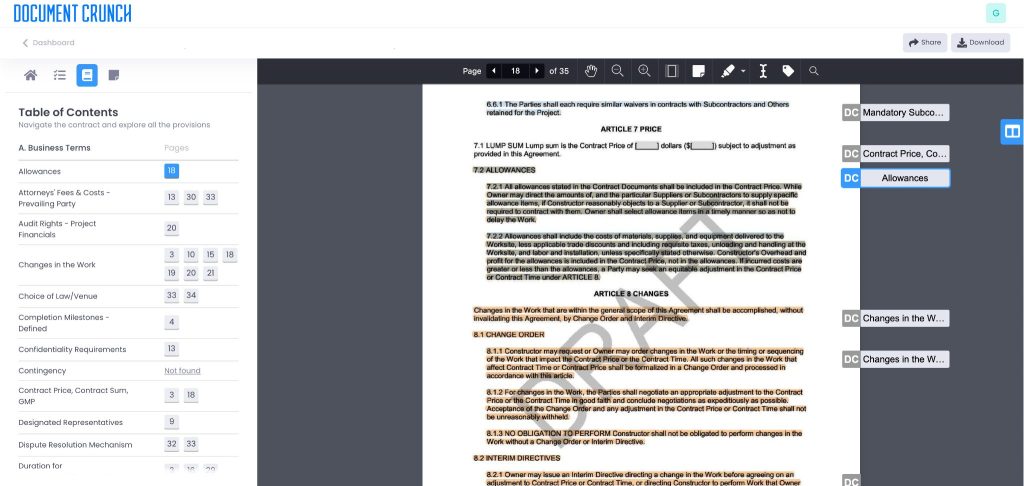Why We Crunch: Construction Lawyers’ Vision for Fixing Broken Contracting Practices

When our co-founders Josh Levy and Adam Handfinger graduated law school (one at the University of Miami and the other at Emory University) they had no intention of raising $10M to build a SaaS product to help the construction industry understand and manage contracts and insurance policies. The two met when Josh clerked one summer for Adam’s firm, which has grown into a prominent national construction law practice. Adam and Josh had front-row seats to the daily pain general contractors face around contracts.
After several years working together in private practice, Josh moved on to an in-house counsel role for an ENR Top 50 contractor. He later transitioned to lead the commercial contracts function for an international EPC contractor focused on renewable energy projects. In these roles, Josh read, interpreted, negotiated then communicated construction contracts on behalf of every employee involved on each project. Josh became overwhelmed with all of the deal flow so he looked to his old mentor Adam (and his growing team) to help provide contract review support. Adam, who ultimately rose to become managing partner of his firm’s Miami Office, and now sits on the Executive Committee nationwide, was acutely aware of so many cutting-edge issues impacting the industry and started thinking about how technology could make our industry more efficient. Josh and Adam have stewarded contracts for billions of dollars worth of construction (and claims) and could summarize their experience in four words:
Construction contracts are broken.
They were deeply inspired by this problem, and along with third co-founder, serial entrepreneur Adam Nadler, they spent several years developing the software to empower everyone at a construction company to understand what’s in their contracts.

Too many contracts, not enough PMs reading them
Imagine the first construction contract agreement that made you go cross-eyed. Multiply that by the number of projects your company works on at any given time. Multiply that by three since your legal team probably reviews 3-5 contracts for every bid they win. Multiply that by how many specialty contractor agreements you’ll need for that project let alone all the other extra documentation like payment apps, lien waivers, NDAs, change orders, notices, etc. Multiply that by how many people on the project team need to understand and make decisions against each contract. This was the volume of paperwork and communication Josh swam in daily in his role as an in-house lawyer. It’s understandable that project teams without such in-house resources may not fully understand their contracts, let alone got the other paperwork right.
In our founders’ situation, Josh worked at large, well-staffed GCs, with multiple lawyers or contract professionals working for him, and often still had to hire Adam’s team for contract help to review mountains of documents and support project claims. As they continued to collaborate, Josh and Adam wondered what the contract review and claims process must look like at small to medium sized contractors who typically do not have budgets for any of these resources. They came to the conclusion that such under-resourced companies were not well-positioned to negotiate and understand their contracts. The contract volume can be overwhelming, but that is just the beginning. Once projects begin, project teams often feel insecure around contracts. Our co-founders wanted to instill confidence in these capable project teams and executives.
All of our co-founders believed technology could help build the confidence of decision-makers. They knew a contract lifecycle management solution for construction would make things easier, project teams more capable, but most importantly, it would achieve the holy grail: reducing unnecessary expenses on projects.
Our co-founders observed that most construction companies are either overinvesting in contract review up front and assuming they got it right, or they’re underinvesting and paying for it when the project is underway with shaky contract terms. Ultimately, no matter whether the back office overinvests or underinvests in the contract process, project managers are left to fend for themselves in the day-to-day of executing the contract. Knowingly or not, if Project Managers (PMs) fail to properly comply with a contract, they cause little things like fee erosion, or big things, like legal claims.
Ultimately, 81% of construction companies say they’ve been hurt financially by a contract.
Software will never replace construction law attorneys
Software could make a lawyer’s job easier, and most importantly it could empower others with information to do their jobs better. Instead of project teams asking their lawyers to translate an entire contract, what if software helped identify the areas they misunderstood or disagreed with, and focused the construction attorney’s time there? What if the technology analyzed their previous contracts and flagged risk exposure? It wouldn’t eliminate the need for in-house counsel or construction litigators, but would instead make sure builders are positioned to make great decisions every day, and are otherwise using attorneys’ very costly time for revenue generating and cost mitigating support.
It doesn’t help that contractors joke, “The final stage of construction is…litigation.”
The construction industry historically has been litigious. That needs to change. Any construction company that’s been involved in a legal battle can tell you the cost in legal fees and reputation. They can also do the math on how much cheaper a contract management software would have been if it’d have prevented the lawsuit. Adam and Josh had personally been involved in hundreds of millions of dollars worth of claims over a decade in the business. In every single one of them, mismanagement of the contract was a factor.
From construction law to construction SaaS

The first user logged into Document Crunch in November of 2019. From the suits to the site, the software gives employees at companies like Balfour Beatty the ability to understand the terms and risks associated with their construction contract agreements.
Project teams can now answer everyday questions like when you need to give notice, why you should give notice, how you submit payment applications, how you manage savings, etc. for themselves.
Document Crunch ensures:
- Project teams can make quicker and smarter decisions to keep projects moving.
- Operations teams see less overhead expenses from billing lawyers and less fee erosion from contract mistakes.
- Construction lawyers focus their billing time on the most complex contract issues.
No software can eliminate construction risk. Accidents will happen. Economic changes will impact material pricing. Unexpected employee turnover may affect project timelines. But when commercial building contracts are clear and everyone is bought in on what they entail, issues get resolved more efficiently.
Why contractors love Document Crunch
In an ideal world, contracts for general contractors would be standardized, streamlined into as few documents as possible, and reused from project to project with little room for error. In the real world, contract agreements vary widely depending on the project plan, location, and participants. A general contractor may self-perform most of the work and need a handful of contracts while a design-builder may need an architect and every specialty contractor possible. Each detail of a project adds modifications to construction contract templates and sometimes adds entirely new agreements.
Since we can’t standardize contracts, yet, we can standardize how we negotiate, manage and analyze them. Document Crunch empowers contractors with a centralized database of contracts, a customizable review process, efficient access to make decisions throughout the project and data analysis to improve future contracts.
While Document Crunch can help you wrangle your contracts now, our AI technology can also bring more predictability and support in assessing the risk of contracts you haven’t even seen yet.
Imagine if your contracts could highlight a risky material price escalation clause AND advise on a better price structure based on the current rate of inflation? We’re already working with one of the largest construction insurers in the world, AXA XL, to provide our users with benchmarking reports on how their contracts compare to their peers. For the sake of your attorneys, your financial health, and especially your project managers, schedule a demo of Document Crunch to get control of your contracts today.
“I think I’ve had some version of document crunching living in my head over the past 15 years I’ve been reviewing construction contracts. After some time, I wouldn’t need to review every word of the contract and could just focus on certain sections. Document Crunch does all of that with the click of a button.” -Jennifer Smith, General Counsel at C&S Companies